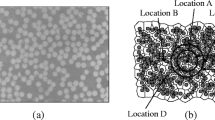Abstract
A model is presented herein for predicting the evolution of numerous cracks on multiple length scales, the objective of such a model being to develop the capability to predict failure of structural components to perform their intended tasks. Such a capability would then be useful as a predictive tool for designing structural components so as not to fail, but rather to succeed in performing their intended tasks. The model developed herein is somewhat involved, being based in continuum mechanics and thermodynamics, but is nevertheless expected to be cost effective (wherever sufficient accuracy permits) when compared to more costly experimental means of determining component life. An essential ingredient within the context of the model is that cracks must develop on widely differing length scales. Where this is observed to occur in nature, which is surprisingly often, there are potential simplifications over more generally described but practically untenable approaches, that can lead to (at least partly) computational multiscale algorithms capable of assimilating failure due to multiple cracking with a high degree of accuracy. The model presented herein will be briefly described within a mathematical framework, and an example problem will be presented that is representative of certain currently relevant technologies.








Similar content being viewed by others
References
Da Vinci L (1970) In: Richter JP (ed) The notebooks of Leonardo Da Vinci
Galileo G (1636) Dialogues concerning two new sciences, Promethus Books
Griffith AA (1920) Philos Trans R Soc Lond A221:163
Eshelby JD (1957) Proc R Soc A421:376
Hashin Z (1964) Appl Mech Rev 17:1
Hill R (1965) J Mech Phys Solids 12:213
Allen DH (2002) Composites Sci Technol 61:2223
Day WA (1972) The thermodynamics of simple materials with fading memory, Springer Tracts in Natural Philosophy. Springer-Verlag, New York
Timoshenko SP (1972) History of strength of materials. McGraw Hill
Allen DH (1994) In: Talreja R (ed) Damage mechanics of composite materials. Elsevier, pp 79–114
Boyd JG, Costanzo F, Allen DH (1993) Int J Damage Mech 2:209
Costanzo F, Boyd JG, Allen DH (1996) J Mech Phys Solids 44(3):333
Allen DH, Yoon C (1998) Int J Solids Struct 35:4035
Vakulenko AA, Kachanov ML (1971) Mekh Tver Tela 4:159
Searcy CR (2004) A multiscale model for predicting damage evolution in heterogeneous media. Ph.D. Thesis. Texas A&M University
Dugdale DS (1960) J Mech Phys Solids 8:100
Barenblatt GI (1962) Adv Appl Mech 7:55
Allen DH, Searcy CR (2001a) Int J Fract 107:159
Allen DH, Searcy CR (2001b) Mech Mater 33:177
Costanzo F, Allen DH (1993) Int J Fract 63(1):27
Costanzo F, Allen DH (1996) Int J Eng Sci 33(15):2197
Yoon C, Allen DH (1999) Int J Fract 96:56
Zocher MA, Allen DH, Groves SE (1997) Int J Numer Methods Eng 40:2267
Foulk JW, Allen DH, Helms KLE (2000) Comput Methods Appl Mech Eng 183:51
Phillips ML, Yoon C, Allen DH (1999) J Eng Mater Technol 21:436
Cauchy A (1823) Bulletin de la Société Philomatique 9
Acknowledgments
The authors are grateful for funding received for this research from the US Army Research Laboratory under contract no. W911NF-04-2-0011.
Author information
Authors and Affiliations
Corresponding author
Rights and permissions
About this article
Cite this article
Allen, D., Searcy, C. A model for predicting the evolution of multiple cracks on multiple length scales in viscoelastic composites. J Mater Sci 41, 6510–6519 (2006). https://doi.org/10.1007/s10853-006-0185-6
Published:
Issue Date:
DOI: https://doi.org/10.1007/s10853-006-0185-6




